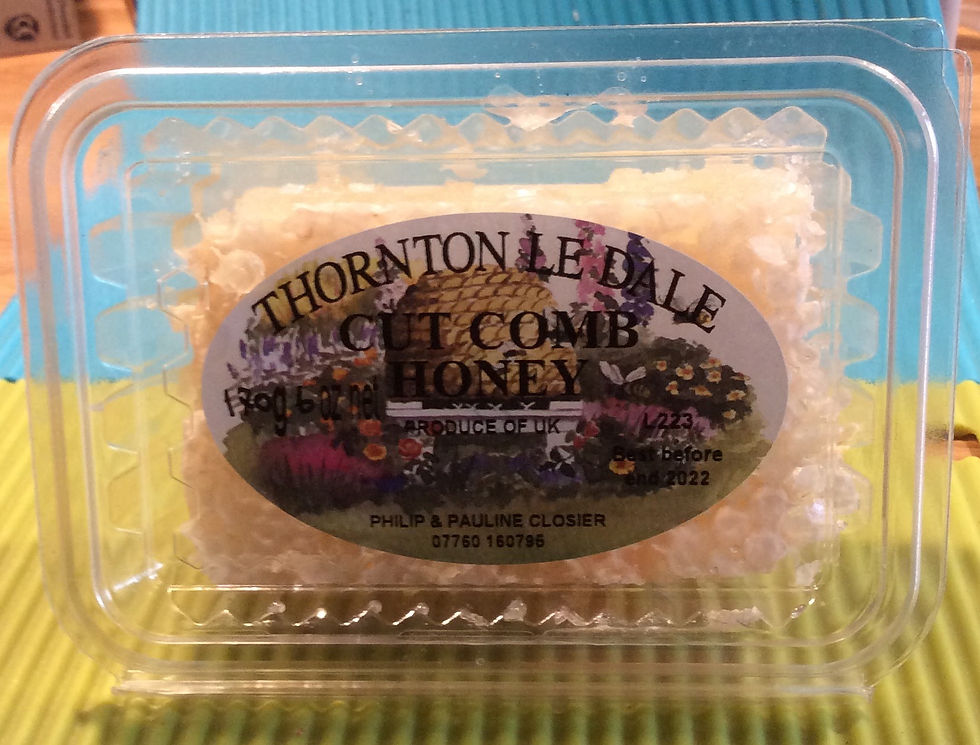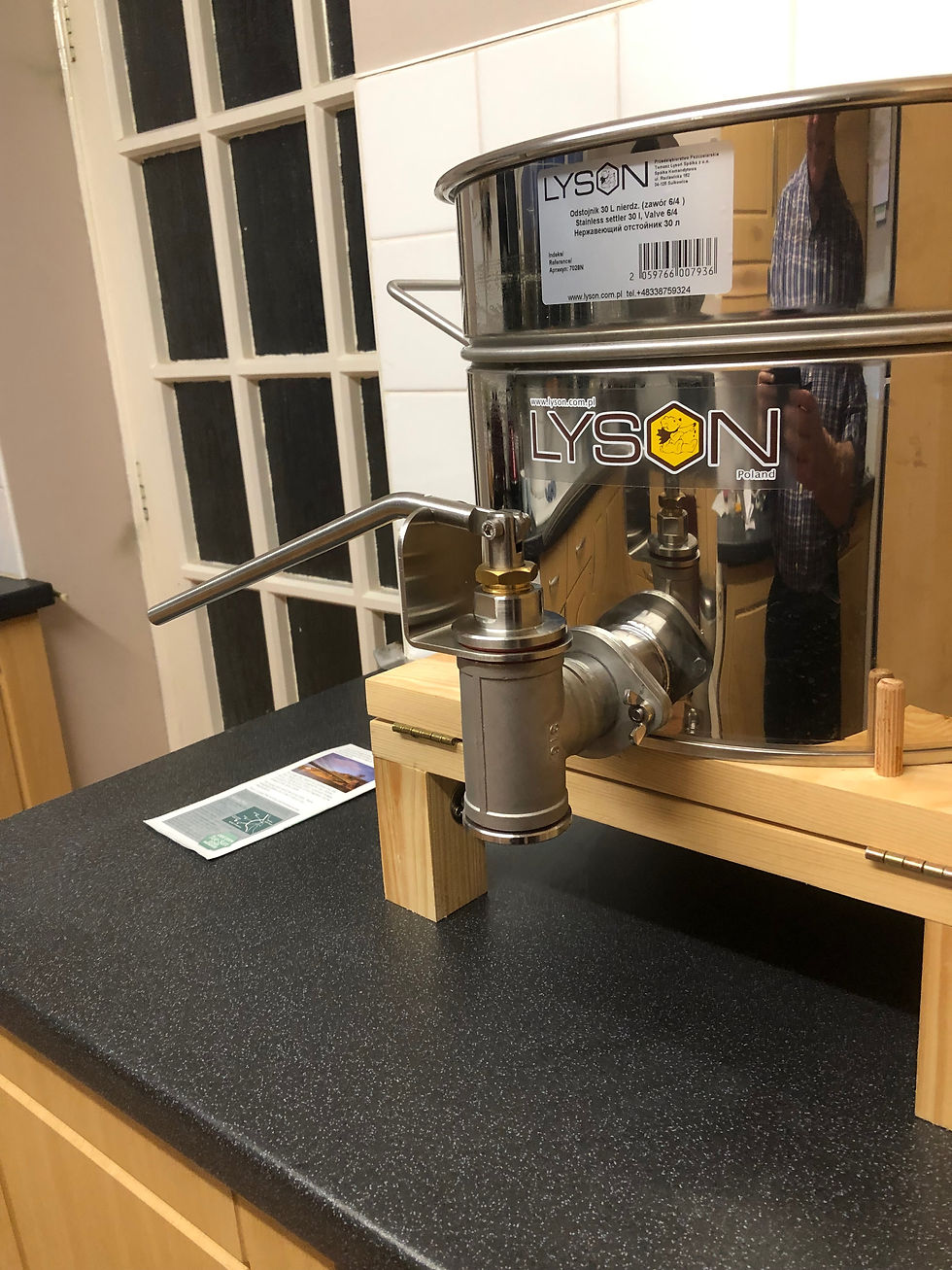Harvesting Honey a quick overview!
- Philip Closier
- Dec 30, 2020
- 6 min read
Hi… foolishly several members have said they want some notes!
This is of course a very personal viewpoint… feel free to take or reject information I put down as you want. I would also suggest you look at the resourceful beekeepers round the world who put stuff up on YouTube for further inspiration.
I will do more detailed notes on individual processes if people again ask.
The first thing I would like to say is that I believe that the handling of honey and wax in bulk is something that we do not think about until it is almost too late!
A healthy colony in a good foraging area will produce a surplus. Don’t feel guilty about having some as your reward for keeping your bees well as long as you ensure they are topped up before winter with syrup if they are left a bit light.
Remember this is a premium food product and you should always do your best to present it well.
The simplest way of getting your harvest is to take the comb and cut it into blocks.All you have to do is get a knife, a board and some plastic boxes… do use unwired foundation for this…..
This is the most fabulous way to eat honey and it always commands a premium price, currently about £10 per 1lb pro rata, the box costs £0.15


If you want it in a jar then this is where your problems so to speak start!!!

Things you should know about honey.
Keep in mind that it absorbs water…… so keep water away from it unless you are cleaning it up, or cooking / brewing with it.
It is sticky, really sticky, very very very sticky… Have you got that point ? if not let me say it again...it is sticky stuff.
It goes everywhere in the house even if you have not been there…. Ask my wife…...
Don’t let it come into contact with any material apart from stainless steel, glass, plastic.
It runs silently….. really … it makes absolutely no noise…so do not turn your back on it..
Gravity and warmth are your best tools in handling honey…
A warming cabinet will take care of the warmth bit.

Now I know what you are thinking, the expense!.... Ok I have a really flash one, it is commercially made, but, you can make one really easily and really cheaply….with an old fridge / freezer and some bits and bobs from ebay…the pictures below are my son Alasdair’s.. it is as you can see a small fridge.. parts from eBay about £25…
You need
Digital thermostat £9.00
Heater unit £10.00
Computer Fans £5.00
This is my son's one as described above, it works really well. As you can see he gets a 30 lb or 50 lb bucket in easily. You can clearly see the heating unit in the bottom, the computer cooling fans to circulate the air , the control box on the top and sensor inside.
Uncapping
You will need a tank for the cappings to drain into…. Well think of a large plastic box / bucket with a draining device on it or buy a capping unit like this that I have used for many years.

In the past I have used a plastic washing up bowl kept for that purpose.
My son uncaps directly into a pasta sieve over a bucket.
I now have a MeliFlow…..

Think of it as a heated horse trough…. Just don't ask how expensive it is… but it earns its keep in the honey recovered from the capping's and the frames where the honey is crystallized.
You can get a large39cm catering style pasta sieve off ebay made of stainless steel for £10 ~ £15

To get the capping's off use a knife ( I used a bread knife for many years, then tried a fork but now I use an electrically heated knife…. £14 off ebay)


Are you getting the picture here… be inventive!!
After getting the cappings off you can put the frames in the extractor and spin them dry.

Spin slowly at first to get the bulk of the honey out of the frames then progressively increase the speed as they get lighter until the frames are dry.
The cappings are full of honey, they are not waste.
Earlier this year I ran some tests..
From one batch of cappings I got 18lb of honey to run off immediately. I then took the left over (42lb of cappings and honey) warmed them… and another 30lb ran off.
So you could put a bucket with a pasta sieve on it loaded with cappings in your warming cabinet and sit back and wait!!
You can get special bags to put the cappings in that you also put into the extractor if the honey is good and runny.
My Pasta Sieve

Extractors
My advice is beg or borrow one from the association or get your mentor to assist you to get started and also to see what you need.
If you are inspired and are flush with cash then choose the one you think you would like. Think about it and then go for a bigger one if you can.
(My son read these notes and commented ..”Don't bother buying one at less than 11 frames eg a super. Avoid 2 frame ones, you'll be there still using it next summer.” )
There are three basic types of extractor, each has their own strengths and weaknesses. You can convert between the types if you need to by changing the basket on some of the really good ones.
Tangential fast but you need to stop and turn the frames over half way through.
Radial No turning frames but you have to spin for longer, so an electric motor is really a must.
Cassette starts off as a radial, converts to tangential, then reverses direction so no turning. But they take less frames ( you need a lot of cash for these!)
I like Radial….
I started with a 10 frame hand cranked radial made by Taylors 40 odd years ago, 4 years ago I went to buy an new 12 frame radial electric one, I left with a 20 frame radial electrical one, it was a really brilliant bit of kit, it took 20 super frames or 8 brood size frames, but I recently upgraded to a 30 frame one with a heated base. It is so big it takes 30 brood size frames, again please don't ask how much...


( a full load of 30 brood frames)
It is a bit more than most people will need but in its first day of use I extracted 90 brood size frames of honey with little effort in just a few hours.
The output from my extractor is always dropped into a stainless steel bucket, £11 off ebay then through the £15 Pasta Sieve into my settling tank to filter out any large lumps of wax etc if I have blown a frame. …(you can use a plastic honey bucket but I worry about the plastic ones breaking and the stainless ones can be really scrubbed clean or run through the dishwasher.)

This is my settling tank , it holds 70 litres of honey and has a heating unit built in. I used big 50lb plastic buckets for many years with a gate valve very successfully. Leaving it to settle basically means we wait for the bubble / pollen and bits of wax to rise to the surface so you can draw cleanish honey off to filter.
The thinking process is that this will prevent clogging your fine sieve.
This is a plastic settling one like I used to use, doubles as a bottling tank.

Don't be tempted by the “vintage” metal ones you will see on ebay occasionally. They are made of tin plated steel and will corrode and ruin your honey.
After that I run the honey (warm) through a fine sieve and into buckets for storage.
( Tip have two sieves if you can to speed things up if one gets clogged)

Write the date on the bucket and use a refractometer to check the water content.
Note that all this is done using gravity and a large spatula. I never scoop or ladle honey.
Bottling Honey
Again… warmth and gravity are the order of the day I warm my honey to about 38C in the cabinet, and put it into my bottling tank
A word about the gate valves on tanks….
Buy a good one. There is no way to describe the sheer panic of trying to close a poor one with 70l (180lb) warm honey fighting to get out……and trust me it is going to succeed and head for the floor, the wall, the ceiling.
A plastic one I particularly like has a guide that keeps the gate in line when there is pressure behind it you can get ones like this from a well known supplier in Lincolnshire, about £5

I admit I currently use an expensive non drip spring loaded dead man's handle one. Work out what 30 litres (85lb) of honey is worth then you will see why I am paranoid about it ending up on the floor!
Never turn your back on honey…. It runs silently…. You have been warned!
My son also commented
“For the smaller scale producer, getting that last 1lbs out of the container is important. I made an adjustable platform with 2 hinges and 2 sheets of ply. It has a wooden wedge at the front to stop the tank sliding forward as it is propped up underneath.”

Whatever your level of production scrape every last bit out….. In the above image you can see his homemade tilting stand.
I hope this has been of interest and of help to you.
Happy Beekeeping
Philip








Comments